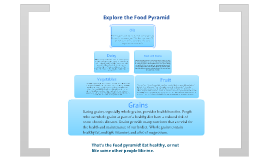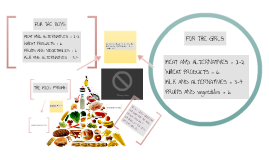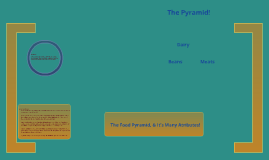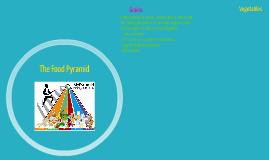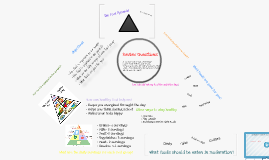The Food Pyramid
Transcript: Explore the Food Pyramid The food pyramid advises that fats be consumed sparingly. Butter and oils are examples of fats. Healthy sources of fat can be found in fish, nuts, and certain fruits and vegetables, such as avocados Milk and dairy products contain many nutrients and provide a quick and easy way of supplying these nutrients to the diet within relatively few calories. Milk, cheese and yogurt all provide the following beneficial nutrients in varying quantities. Calcium, Phosphorous, Magnesium, Protein, Vitamin B12, Vitamin A, Zinc, Riboflavin, Folate, Vitamin C and Iodine. A vegetable is a part of a plant consumed by humans that is generally savory but is not sweet. Vegetables contain many vitamins and minerals green vegetables typically contain vitamin A, dark orange and dark green vegetables contain vitamin C,and vegetables like broccoli and related plants contain iron and calcium. Vegetables are very low in fats and calories, but ingredients added in preparation can often add these. Vegetables are packed with essential vitamins, minerals, fiber, and disease-fighting phytochemicals. In terms of food, fruits are the sweet-tasting seed-bearing parts of plants, or occasionally sweet parts of plants which do not bear seeds. These include apples, oranges, plums, bananas, etc. Fruits are low in calories and fat and are a source of natural sugars, fiber and vitamins. Processing fruits when canning or making into juices may add sugars and remove nutrients. The fruit food group is sometimes combined with the vegetable food group. Note that many foods considered fruits in botany because they bear seeds are not considered fruits in cuisine because they lack the characteristic sweet taste, e.g., tomatoes or avocados. That's the Food pyramid! Eat healthy, or not like some other people like me. Fruit Meat and beans are both included in the protein section of the food pyramid and should have a place in your diet. Lean meats, such as white meat chicken and turkey, beef, pork and fish are a healthy addition to your menu that help you reach the 5 to 6 oz. you need each day. Lean meats supply just as much protein as fattier meats but less unhealthy saturated fat. Beans can replace meat while still providing many of the same benefits. They provide protein, fiber, vitamins and minerals. Eating grains, especially whole grains, provides health benefits. People who eat whole grains as part of a healthy diet have a reduced risk of some chronic diseases. Grains provide many nutrients that are vital for the health and maintenance of our bodies. Whole grains contain healthy fat, multiple vitamins, and a lot of magnesium. Grains Meat and Beans Vegetables Oils Dairy






